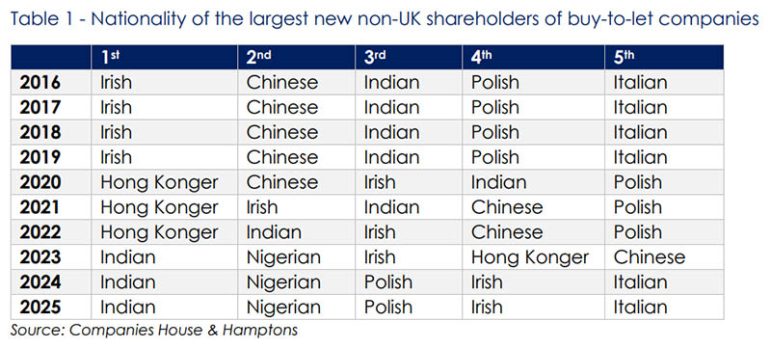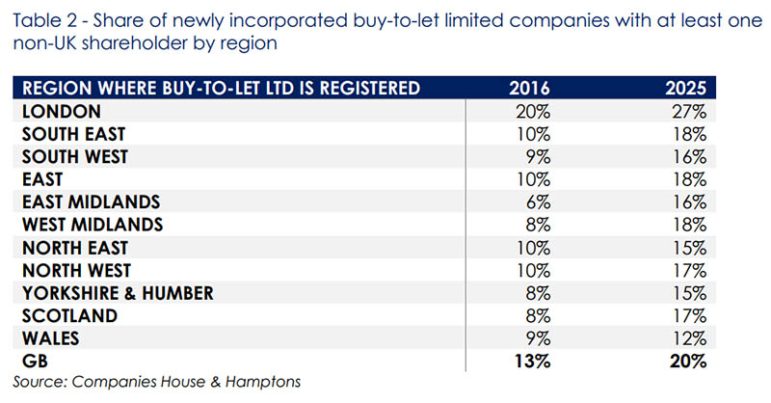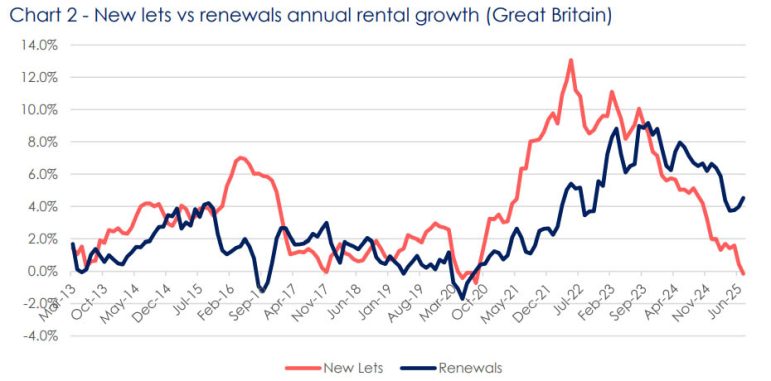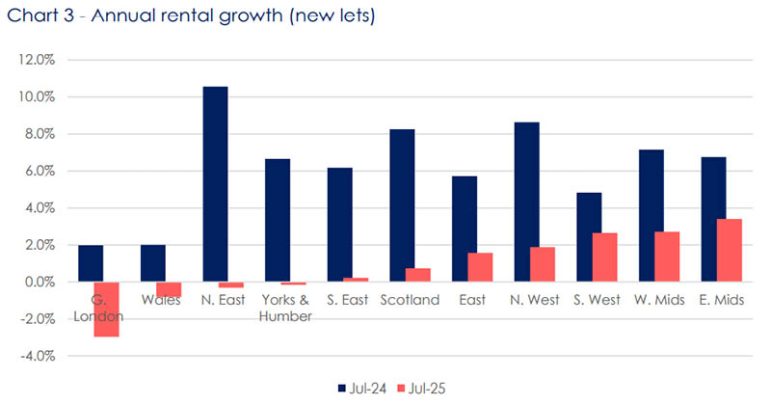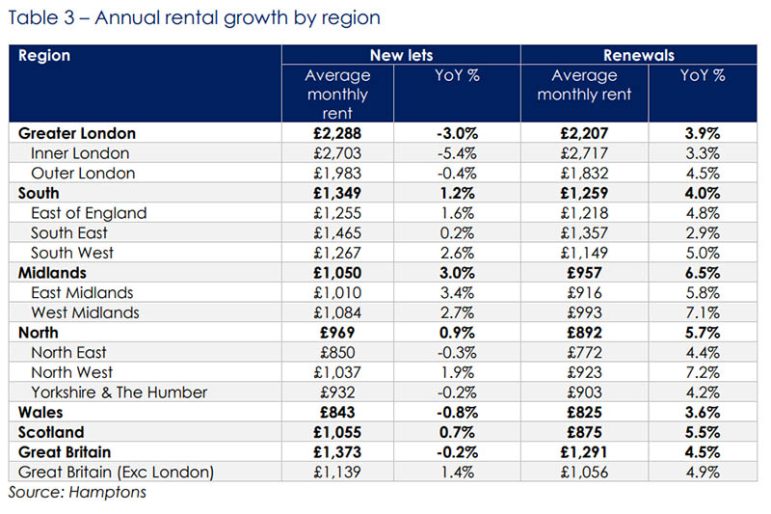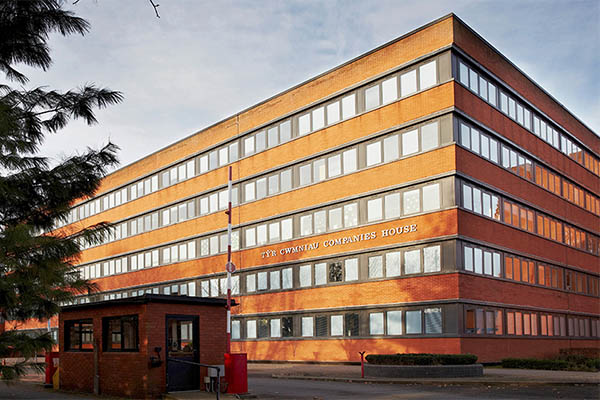
Hamptons has analysed Companies House data and found that one in five (20%) buy-to-let companies set up in the UK so far this year are owned by non-UK national shareholders, with the others owned by UK shareholders.
It’s a figure that has grown from 13% in 2016, rising in nine of the last 10 years.
The analysis is based on newly established buy-to-let limited companies where Companies House lists one or more shareholders as a non-UK national. This means that while these shareholders are not British citizens, they may reside in the UK. New companies may hold newly bought properties as well as buy-to-lets that have been transferred from personal ownership into a limited company structure.
The number of buy-to-let companies set up across the UK in 2025 is running 8% ahead of last year’s record levels. At the current rate, that equates to around 67,000 new companies being set up by the end of 2025, with around 13,500 owned, at least in part, by non-UK nationals.
61% of buy-to-let companies set up so far this year had more than one shareholder. In most cases, shareholders tend to share the same nationality. Among all companies set up by non-UK nationals this year, 84% are owned by shareholders of the same nationality.
International ownership of new buy-to-let companies has typically followed wider post-Brexit migration trends. While the overall share of non-UK national shareholders has risen, there has been a pivot away from EU nationals. In 2016, 65% of non-UK shareholders came from the EU, but this figure has fallen to 49% in 2025.
There has also been a general fall in shareholders from English-speaking countries. In 2016, Irish, Americans, South Africans and Australians all featured in the top 10 but by 2025, only Irish nationals remained, ranking fourth (table 1).
Instead, ownership has moved towards South Asia. Indians have made up the largest group of non-UK shareholders every year since 2023. In 2022, they were the second largest nationality among non-UK national purchasers, behind Hong Kongers.
In the first half of the year, 684 new buy-to-let companies were founded by Indian nationals, with more registered in Hillingdon than in any other Local Authority in the country. Pakistani shareholders also comprise the 10th largest non-UK nationality so far in 2025.
Nationals from Africa first made it into the top 10 list of non-UK shareholders in 2020. However, since 2023, Nigerians have ranked as the second-largest group of non-UK national shareholders in newly formed buy-to-let companies (table 1). In H1 2025, they formed 647 new buy-to-let companies.
Despite the shift away from EU nationals in general, Eastern European nationalities have bucked the trend. Both Polish and Romanian nationals now make up a larger share of new buy-to-let shareholders than they did in 2016, setting up 473 and 208 companies in H1 2025 respectively.
Non-UK nationals make up the largest proportion of shareholders in buy-to-let companies registered in London – a trend that has remained unchanged between 2016 and 2025. This year, 27% of new buy-to-let companies registered in the capital are owned by non-UK nationals (table 2). Over half of the new companies set up in Kensington & Chelsea (54%) and Hammersmith & Fulham (51%) were owned by non-UK nationals.
However, regions outside the capital have generally seen the largest growth in foreign ownership. Between 2016 and 2025, the share of new non-UK national landlords more than doubled in the East Midlands, West Midlands and Scotland (table 2). Runnymede saw the highest share of new companies set up by non-UK nationals this year of any other local authority in the country, at 59%.
Rental growth
Rents across Great Britain have fallen for the first time in five years. The average rent on a newly let property fell 0.2% year-on-year in July, marking the first annual decline since August 2020, during the height of the Covid pandemic. Despite this, the average rent of £1,373 pcm remains £350 or 34% higher than in August 2020 (chart 2, table 3).
These rent falls are not yet widespread. Rents are still rising in seven out of 11 regions, with the East Midlands (3.4%), West Midlands (2.7%) and South West (2.6%) leading the way (chart 3, table 3).
Greater London continues to record the steepest declines, with rents falling 3.0% year-on-year in July – its seventh consecutive monthly decline and the biggest annual drop since May 2021. Wales also saw rents decline on an annual basis for the third month in a row, while the North East (-0.3%) and Yorkshire & the Humber (-0.2%) joined the club in July (chart 3, table 3).
The North of England has seen the sharpest slowdown over the last year, bringing the national figure into negative territory. Just a year ago, rents were rising at a double-digit pace in the North East (10.6%), with 6.7% growth in Yorkshire and the Humber and 8.6% in the North West (chart 3).
Meanwhile, rents on renewed tenancies continued to rise, up 4.5% year-on-year in July (table 3). The pace of rental growth for renewed contracts has accelerated for the fourth consecutive month, with every region recording increases. The North West saw the strongest growth, with rents on renewed tenancies rising 7.2% year-on-year, more than triple the pace of the rental growth for new lets (table 3).
The average rent on a renewal in Great Britain now stands at £1,290 pcm – just £83 less than the rent where a new tenant moves in. This is the smallest gap in four years, with landlords keen to keep renewal rents closer to market levels and more closely mirroring broader inflation.
Aneisha Beveridge, head of research at Hamptons, said of the latest report: “Despite the challenges facing landlords, non-UK nationals are increasingly embracing UK buy-to-let. The London market has long been an international one, well-known across East Asia, the US, and the EU. However, demand from non-UK nationals has steadily been shifting into lower value markets outside the capital, where the bulk of growth in both house prices and rents has been seen in recent years.
“While overseas-based investors are part of the picture, the majority of purchases by non-UK nationals reflect domestic demand. Up until 2021, this demand was most likely to come from EU nationals based in the UK, but since then, it has shifted to reflect changes in broader migration patterns. Indian and Nigerian nationals are increasingly likely to buy UK buy-to-let property in a limited company structure.
“After five years of relentless rent rises, the market has paused for breath. Rents on new lets have dipped for the first time since 2020, as falling mortgage rates and a cooling economy ease pressure on the market. But for sitting tenants, the story is different. Renewal rents continue to climb, with landlords keen to keep pace with inflation and close the gap with market rates. It’s a sign that while demand may be softening, the underlying cost pressures haven’t gone away.”
Read the orginal article: https://propertyindustryeye.com/growth-in-buy-to-let-incorporations-driven-by-international-landlords/

